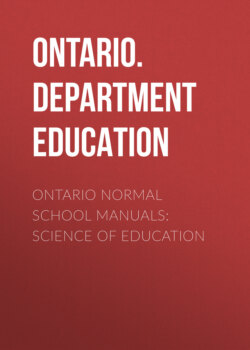Читать книгу Ontario Normal School Manuals: Science of Education - Ontario. Department of Education - Страница 51
На сайте Литреса книга снята с продажи.
HOW TO SET LESSON PROBLEM
ОглавлениеTable of Contents
Precautions.—If the teacher expects his pupils to become interested in a problem by immediately recognizing a connection between it and their previous knowledge, he must avoid placing the problem before them in a form in which they cannot readily apprehend this connection. The teacher who announced at the beginning of the grammar lesson, "To-day we are going to learn about Mood in verbs" started the problem in a form that was meaningless to the class. The simplest method in such a lesson would be to draw attention to examples in sentences of verbs showing this change and then say to the class, "Let us discover why these verbs are changed." Similarly, to propose as the problem of the history lesson "the development of parliamentary government during the Stuart period" would be to use terms too difficult for the class to interpret. It would be better to say: "We are going to find out how the Stuart kings were forced by Parliament to give up control of certain things." Instead of saying, "We shall study in this lesson the municipal government of Ontario," it would be much better to proceed in some such way as the following: "A few days ago your father paid his taxes for the year. Now we are going to learn by whom, and for what purposes, these taxes are spent." Similarly, "Let us find out all we can about the cat," would be inferior to, "Of what use to the cat are his sharp claws, padded feet, and rough tongue?"
On the other hand, it is evident that, in attempting to present the problem in a form in which the pupils may recognize its connection with their previous experiences, care must be taken not to tell outright the whole point of the lesson. In a lesson on the adverb, for instance, it would not do to say: "You have learned how adjectives modify, or change the meaning of, nouns. To-day we shall study words that modify verbs." A more satisfactory way of proceeding in such a lesson would be to have on the black-board two sets of sentences exactly alike except that the second would contain adverbs and the first would not. Then ask: "What words are in the second group of sentences that are not in the first? Let us examine the use of these words." In the same way, to state the problem of an arithmetic lesson as the discovery of "how to add fractions by changing them to equivalent fractions having the same denominator" is open to the objection of telling too much. In this case a better method would be to present a definite problem requiring the use of addition of fractions. The pupil will see that he has not the necessary arithmetical knowledge to solve the problem and will then be in the proper mental attitude for the lesson.
